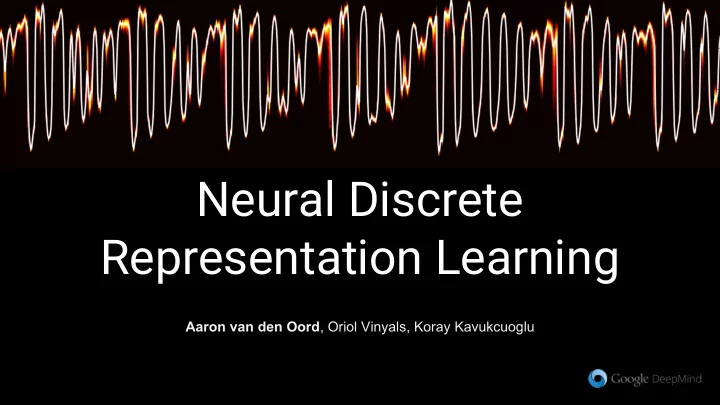

Neural Discrete Representation Learning Aaron van den Oord , Oriol Vinyals, Koray Kavukcuoglu
Generative Models Goal : Estimate the probability distribution of high-dimensional data Such as images, audio, video, text, ... Motivation: Learn the underlying structure in data. Capture the dependencies between the variables. Generate new data with similar properties. Learn useful features from the data in an unsupervised fashion.
Autoregressive Models
Recent Autoregressive models at DeepMind Geyser White Whale Hartebeest Tiger PixelRNN PixelCNN Video Pixel Networks van den Oord et al, 2016ab Kalchbrenner et al, 2016a WaveNet ByteNet van den Oord et al, 2016c Kalchbrenner et al, 2016b
Modeling Audio
Causal Convolution Hidden Layer Input
Causal Convolution Hidden Layer Hidden Layer Input
Causal Convolution Hidden Layer Hidden Layer Hidden Layer Input
Causal Convolution Output Hidden Layer Hidden Layer Hidden Layer Input
Causal Convolution Output Hidden Layer Hidden Layer Hidden Layer Input
Causal Dilated Convolution Input
Causal Dilated Convolution Hidden Layer Input
Causal Dilated Convolution Hidden Layer dilation=2 Hidden Layer dilation=1 Input
Causal Dilated Convolution Hidden Layer dilation=4 Hidden Layer dilation=2 Hidden Layer dilation=1 Input
Causal Dilated Convolution Output dilation=8 Hidden Layer dilation=4 Hidden Layer dilation=2 Hidden Layer dilation=1 Input
Causal Dilated Convolution Output dilation=8 Hidden Layer dilation=4 Hidden Layer dilation=2 Hidden Layer dilation=1 Input
Multiple Stacks
Sampling
Speaker-conditional Generation ... Speaker embedding Does not depend on timestep
https://deepmind.com/blog/wavenet-generative-model-raw-audio/ Text-To-Speech samples
https://deepmind.com/blog/wavenet-generative-model-raw-audio/ Speaker-conditional samples (but not conditioned on text)
https://deepmind.com/blog/wavenet-generative-model-raw-audio/ Piano Music samples
VQ-VAE - Towards modeling a latent space - Learn meaningful representations. - Abstract away noise and details. - Model what’s important in a compressed latent representation. - Why discrete? - Many important real-world things are discrete. - Arguably easier to model for the prior (e.g., softmax vs RNADE) - Continuous representations are often inherently discretized by encoder/decoder.
VQ-VAE Related work: PixelVAE (Gulrajani et al, 2016) Variational Lossy AutoEncoder (Chen et al, 2016)
VQ-VAE
VQ-VAE
Images
ImageNet reconstructions Original 128x128 images Reconstructions
VQ-VAE - Sample
ImageNet samples
DM-Lab Samples
3 Global Latents Reconstruction
3 Global Latents Reconstruction Originals Reconstructions from compressed representations (27 bits per image).
Video Generation in the latent space
Speech
https://avdnoord.github.io/homepage/vqvae/
Speech - reconstruction Original Reconstruction
Speech - Sample from prior
https://avdnoord.github.io/homepage/vqvae/
Speech - speaker conditional
https://avdnoord.github.io/homepage/vqvae/
Unsupervised Learning of phonemes Phonemes Discrete codes Decoder Encoder alphabet = codebook
Unsupervised Learning of phonemes 41-way classification 49.3 % accuracy fully unsupervised Phonemes Discrete codes
References and related work Pixel Recurrent Neural Networks - van den Oord et al, ICML 2016 Conditional Image Generation with PixelCNN Decoders - van den Oord et al, NIPS 2016 WaveNet: A Generative Model For Raw Audio - van den Oord et al, Arxiv 2016 Neural Machine Translation in Linear Time - Kalchbrenner et al, Arxiv 2016 Video Pixel Networks - Kalchbrenner et al, ICML 2017 Neural Discrete Representation Learning - van den Oord et al, NIPS 2017 Related work: The Neural Autoregressive Distribution Estimator - Larochelle et al, AISTATS 2011 Generative image modeling using spatial LSTMs - Theis et al, NIPS 2015 SampleRNN: An Unconditional End-to-End Neural Audio Generation Model - Mehri et al, ICLR 2017 PixelVAE: A Latent Variable Model for Natural Images - Gulrajani et al, ICLR 2017 Variational Lossy Autoencoder - Chen et al, ICLR 2017 Soft-to-Hard Vector Quantization for End-to-End Learning Compressible Representations - Agustsson et al, NIPS 2017
Thank you!
Recommend
More recommend